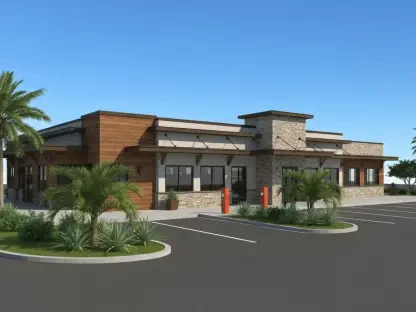Alberta’s dining landscape is experiencing a remarkable renaissance, with restaurant sales climbing to impressive new levels, fueled by a dynamic mix of local and international influences. According to recent data highlighted in reports from Calgary, the province saw a striking 6.8% increase in restaurant revenues in May compared to the same period last year, marking a significant uptick in the hospitality sector’s performance. This growth isn’t merely a regional anomaly but reflects a broader national trend where dining establishments across Canada are seeing heightened activity. What’s behind this surge in Alberta? A potent combination of evolving travel behaviors, a swell in visitor numbers from south of the border, and favorable economic conditions has transformed the province into a culinary hotspot. As more people choose to dine out, the ripple effects are felt not just in bustling urban centers like Calgary and Edmonton, but also in smaller communities eager to cater to a growing clientele.
This boom in Alberta’s restaurant industry paints a vivid picture of resilience and adaptability. Beyond the raw numbers, the story unfolds through the choices of Canadians opting to explore local flavors instead of venturing abroad, alongside a notable influx of American tourists seeking unique experiences in the province. These shifts are complemented by a rapidly expanding population base that continues to drive demand for diverse dining options. However, while the current outlook radiates optimism, there are whispers of caution as external pressures like geopolitical tensions could cast shadows over future consumer spending. Delving deeper into these factors reveals a multifaceted narrative of growth, opportunity, and potential challenges that Alberta’s hospitality sector must navigate in the coming months.
Tourism Shifts Fuel Restaurant Growth
Domestic Travel Boosts Local Spending
A significant pivot in Canadian travel habits, spurred by geopolitical undercurrents and cross-border uncertainties, has directly invigorated Alberta’s hospitality revenues. With a reported 7.2% decline in Canadians returning from the U.S. through Calgary and Edmonton airports in June compared to the prior year, there’s a clear trend toward staying closer to home. This shift isn’t merely a statistic but a cultural movement, often dubbed “buy local,” where residents are choosing to invest their dollars in domestic experiences. Restaurants across Alberta, from cozy diners to high-end bistros, are reaping the benefits as more patrons fill their tables, opting for local cuisine over international getaways. This redirection of spending has created a robust foundation for the province’s dining sector, ensuring a steady flow of revenue that supports both established venues and emerging culinary talents looking to make their mark in a competitive market.
Beyond the immediate financial boost, this focus on domestic travel highlights a broader sense of community engagement within Alberta. Local eateries are becoming more than just places to eat; they’re evolving into cultural hubs where residents reconnect with their surroundings and celebrate regional flavors. The decline in cross-border trips has encouraged a rediscovery of what Alberta has to offer, from farm-to-table establishments showcasing the province’s agricultural bounty to urban spots experimenting with global fusion dishes. This renewed interest is fostering a vibrant food culture, where loyalty to local businesses strengthens economic ties and builds resilience against external fluctuations. As Canadians continue to prioritize experiences within their borders, the hospitality sector stands to gain from sustained patronage that could shape long-term growth patterns in the industry.
Surge in American Visitors
Meanwhile, an impressive 11% uptick in American tourists arriving via Alberta’s airports has injected a fresh wave of revenue into the province’s restaurant scene. These visitors, often drawn by the stunning landscapes of Banff and Jasper or the urban allure of Calgary and Edmonton, are not just passing through—they’re dining out in significant numbers. This influx has turned Alberta into a must-visit destination for food enthusiasts from south of the border, eager to sample everything from hearty comfort food to innovative culinary creations. The resulting boost in sales is a testament to the province’s appeal as a travel spot, with hospitality businesses adapting to meet the diverse tastes of an international crowd, ensuring menus cater to a wide array of preferences while maintaining a distinct Canadian identity.
This surge in American visitors also underscores Alberta’s growing reputation as a global tourism hub, further amplifying its economic vitality. Restaurants are seizing the opportunity to showcase local ingredients and unique dining experiences that leave lasting impressions on travelers. From themed eateries that highlight the province’s cowboy heritage to upscale venues offering panoramic views alongside gourmet dishes, the hospitality sector is capitalizing on this wave of interest. Moreover, the increased foot traffic from U.S. guests has spurred job creation and investment in infrastructure, as businesses expand to accommodate the demand. While this growth is a clear win for Alberta’s economy, it also places pressure on the industry to maintain high standards of service and authenticity, ensuring that the province remains a top choice for international diners in the long run.
Demographic and Economic Drivers
Population Boom Increases Demand
Alberta’s rapid demographic expansion, with over 200,000 new residents last year and projections of another 120,000 by year-end, is a powerful engine driving the demand for dining options across the province. This population boom translates into more customers seeking meals outside the home, whether for casual family outings or special occasions, placing restaurants at the heart of community life. The influx of new residents, often drawn by job opportunities and a high quality of life, has created a diverse consumer base with varied culinary preferences, pushing eateries to innovate and expand their offerings. Simultaneously, this growth has bolstered the labor supply within the hospitality sector, enabling businesses to scale operations and meet the rising appetite for their services without compromising on quality or efficiency.
The ripple effects of this population increase extend beyond mere numbers, reshaping the very fabric of Alberta’s dining landscape. Neighborhoods once quiet are now bustling with new cafes and bistros, catering to a growing clientele eager for convenience and variety. This demographic shift also brings cultural diversity, introducing a demand for international cuisines alongside traditional Canadian fare, which enriches the province’s food scene. Employment in the food and accommodation industry has seen a notable 4.9% rise in the first half of the year compared to last, reflecting how the sector is absorbing new workers to keep pace with demand. As Alberta continues to attract newcomers, the sustained pressure on restaurants to adapt and thrive highlights the critical role of strategic planning in maintaining service standards amid such rapid change.
Economic Conditions Support Spending
A notable easing of inflation, dropping to 3.6% in 2024 from a high of 5.9% the previous year, has provided Albertans with more disposable income to enjoy dining out, bolstering the hospitality sector’s revenue stream. This economic relief means that families and individuals alike can allocate a larger portion of their budgets to experiences like meals at local restaurants, rather than tightening belts on discretionary spending. The improved financial climate has fostered a sense of confidence among consumers, encouraging them to explore new dining venues or indulge in familiar favorites more frequently. As a result, eateries across Alberta are witnessing a steady flow of patrons, which supports not only their bottom line but also the broader economic ecosystem tied to food service, from suppliers to staff.
However, the revenue growth in Alberta’s restaurants isn’t solely a reflection of increased foot traffic; strategic pricing adjustments also play a significant role. Over recent years, menu prices have risen, contributing to the reported 6.8% sales increase in May compared to the prior year. This suggests that while more people are dining out thanks to favorable economic conditions, the uptick in earnings may partly stem from higher costs passed on to consumers. Businesses are navigating a delicate balance—ensuring affordability while covering operational expenses in an industry known for tight margins. This dynamic underscores the complexity of interpreting sales data, as it intertwines consumer behavior with market-driven pricing strategies, painting a nuanced picture of growth that requires careful analysis to fully understand its sustainability over time.
Future Outlook and Challenges
Geopolitical Tensions Loom
While Alberta’s restaurant industry currently enjoys a wave of success, looming geopolitical tensions, particularly the specter of proposed U.S. tariffs, pose potential risks to broader consumer confidence across Canada. Such external pressures could influence spending habits, as households might prioritize essential expenses over discretionary activities like dining out if economic uncertainty grows. Economist Siddhartha Bhattacharya from ATB has noted that these developments could cast a shadow over the national economy, potentially curbing the momentum seen in hospitality sectors. For Alberta, which benefits significantly from cross-border tourism, any disruption in travel or trade relations with the U.S. could have a pronounced effect, prompting businesses to brace for shifts in both visitor numbers and local patronage in the months ahead.
The implications of these geopolitical challenges extend to how Alberta’s restaurants plan for resilience amid uncertainty. A potential downturn in consumer spending might force eateries to rethink promotional strategies or menu offerings to maintain customer loyalty without sacrificing profitability. Additionally, the interconnected nature of global economics means that local businesses are not immune to international ripples, such as supply chain disruptions or currency fluctuations that could raise costs. While the immediate outlook remains strong, the industry must stay vigilant, monitoring policy changes and public sentiment that could alter the dining landscape. Preparing for these scenarios involves not just reactive measures but proactive steps, like diversifying revenue streams or strengthening local supplier networks to mitigate risks tied to cross-border dependencies.
Resilience in Hospitality Sector
Despite the uncertainties tied to external pressures, Alberta’s hospitality sector exhibits a remarkable capacity to withstand potential economic headwinds compared to other industries. The current strength, driven by a potent mix of tourism growth and demographic expansion, provides a solid buffer against downturns that might affect broader consumer spending. Experts suggest that restaurants in the province are well-positioned to maintain stability, thanks to consistent demand from both residents and visitors who continue to prioritize dining experiences. This resilience is further supported by the sector’s adaptability, as businesses have shown an ability to pivot in response to changing market conditions, ensuring they remain relevant and appealing to a wide audience.
Looking ahead, the focus for Alberta’s restaurant industry lies in sustaining this momentum through innovative approaches and community engagement. Building on the current wave of success, eateries could explore partnerships with local producers to enhance menu authenticity while reducing reliance on volatile international supply chains. Additionally, leveraging digital tools to enhance customer experiences—such as streamlined online ordering or personalized marketing—could help maintain loyalty even if economic conditions tighten. As the province’s dining scene continues to flourish, the emphasis should be on fostering a sustainable model that balances growth with preparedness, ensuring that the hospitality sector remains a cornerstone of Alberta’s economy regardless of future challenges that may arise.









